Planting grape cuttings: preparation, timing and rules
Everyone knows what benefits the human body brings grape... But he is loved not only for this, but also for the taste and aroma of elastic fruits. If earlier residents of the southern regions could enjoy this berry to their heart's content, now grapes are conquering new territories, growing in the northern latitudes.
The best method for propagating grapes at home is considered vegetative, which includes cuttings. This method is supported by its availability, simplicity and effectiveness.
Content:
- Choosing the best grape varieties to grow
- Preparation of cuttings, their germination
- Terms and rules for planting grape cuttings
- Vine planting care
Choosing the best grape varieties to grow
How to understand varietal diversity grapes? To do this, you need to understand for what purpose the gardener is going to grow a tasty berry. Bunches of large sweet berries are often harvested from bushes of table varieties, dishes with which decorate dessert tables. Technical types are good for making wine. And versatile and pleasant to feast on, and the drinks from them are of excellent quality.
The best grape varieties that give good yields are those that are not afraid of frost and resist disease:
- One of the earliest species of berry plant is Tason with large oval fruits in seven hundred gram bunches. It is characterized by high productivity, disease resistance.
- A lot of good things can be said about the Zabava variety: it gives large yields of dark blue sweet berries that do not deteriorate during storage, transportation, and do not spoil by wasps.
- Many people know about Kishmish. Yellow-green berries do not have seeds, they are distinguished by sweetness and aroma.
- And for frost resistance and productivity, the technical varieties Isabella, Muscat are appreciated, which are used to make grape drinks.
- But for Amur Potapenko, the main thing is stable harvests even in unfavorable periods of growth.
- Druzhba grapes are equally used for food and for the preparation of white table wines, characterized by a pronounced taste of Muscat. This variety is not afraid of frost even below twenty degrees, it is not susceptible to disease.
- The dessert variety Krassen has a high protection, it takes root well in summer cottages. The berries do not have seeds, so they are good for food, and the wine from it is simply wonderful.
Any gardener prefers only the best grape varieties on his site, but when choosing them, you need to take into account the peculiarities of the climate and soil of the garden.
Preparation of cuttings, their germination
Vegetative propagation of grapes begins with the preparation of cuttings, which are cut from the beginning of autumn to the middle. To do this, choose only healthy, powerful bushes with a vine at least seven millimeters thick. Best of all, cuttings taken not on the sides of the vine, but from its central part, take root and grow. The cut area is just over half a meter. After the process of cutting the cuttings, they are cleaned of greens, mustaches, stepsons. The place of the lower cut should be under the knot, and the upper one should be two centimeters above the eye.
A prerequisite for the further growth of the cutting should be the presence of at least four buds on it.
Cut cuttings it is necessary to completely immerse them in water for a day, after which they are sprayed with a three percent solution of ferrous sulfate, and the cut parts are placed in molten wax for a while. These manipulations will protect the planting material from drying out, save it from mold and rot.
Cuttings tied with a cord in bunches are placed in storage either in the ventilated part of the basement, or in the lower drawers of the refrigerator. You can store them in polyethylene bags, standing upright.
Preparatory work for rooting cuttings begins in the first days of March:
- A cross-section is made on each shoot to check if it is alive or not. And on the cut of the kidneys, their activity is determined. The vine should not have any spots, damage, and the color of the bast should surprise with the freshness of the greenery.
- Then cuttings with two or three eyes are cut from the tested vine. Cut lines should be at the top perpendicular to the vertical axis of the branch, one centimeter above the eye, at the bottom - under the knot with a slight slope from it.
- After such an update, with a sharp knife in the longitudinal direction, grooves are made along the bark of the cutting.
- Prepared branches are placed in containers with melt or running water, to which biostimulants such as sodium humate or heteroauxin, honey are added. As soon as the buds begin to swell on the vine, it is pulled out of the water.
Now it's time to plant grapes in pots filled with nutritious soil, either in a specially designated area of the greenhouse, or immediately in the pits for grape planting, prepared in advance in the garden. In order for root rudiments, keels, to form at the ends of the cuttings, it is necessary to create warm conditions for the lower part, and keep the tops in the cold.
In one more way germination cuttings, with a small number of them, is to place them in water at room temperature or in wet polyethylene bags, which are placed horizontally on the shelves of the cabinet. Properly prepared material for planting grapes will allow in the spring to plant it in open ground.
Terms and rules for planting grape cuttings
Before planting the cuttings in a permanent place, choose a place in the garden from the south or southwest side. Then they will not be afraid of the north and north-east winds. The soil for the vine is needed with neutral acidity or light acidification.
Planting cuttings is planned when the soil temperature reaches ten degrees at a depth below 20 centimeters. The average time for planting grapes will be the second half of April - early May. Planting is not recommended later than the twentieth day of the last spring month, since the vine takes root worse and can dry out as a result of increased evaporation of moisture. The soil for planting is dug up, loosened, brought into it organic and mineral fertilizers... After that, grooves are formed, which are well saturated with moisture, spilling from a hose.
The cuttings are immersed up to forty centimeters deep, leaving the upper bud on the surface.
Thoroughly watered beds are mulched around the sprouts with peat or wet sawdust. Here and the peephole can fall asleep. To create a greenhouse effect, a film is stretched over the plantings, which is removed twenty days after the roots appear in a young vine. First, they open the shelter for an hour, increasing the time every day, accustoming the plant to fresh air. Cuttings take root best of all, in which the rudiments of roots, keels, appeared before planting. The choice of planting date largely depends on weather conditions, on the condition of the soil in the garden.
Vine planting care
The main thing in planting care grapes consider providing them with normal moisture. Watering is carried out every four days with weak rooting of the vine, then it is reduced to once every two weeks. Watering stop at the end of summer for better ripening of the shoots. Loosening and mulching beds.The process of loosening, especially at first, should be carried out carefully, without damaging the weak roots of the grapes. Then it is increased up to twice a month.
The vine does not love around it weeds... They are removed until they become strong and are not rooted in the ground. A month later, they begin to bring into the ground feedingconsisting of urea (ten grams), superphosphate (fifteen grams), potassium salt (ten grams), which are dissolved before adding in ten liters of water. The next time the plantings are fertilized in the second half of summer, using phosphates (20 grams) and potassium salt (ten grams).
Using the correct method of planting and caring for rooted vines will help keep it viable for years to come.
Propagation of different grape varieties by cuttings is most beneficial because they take root and take root easily. This method does not require special knowledge and skills; even a novice gardener can use it. Our material tells how to prepare cuttings, how best to root them, how to plant them in open ground in order to ensure active growth and vitality.
More information can be found in the video:



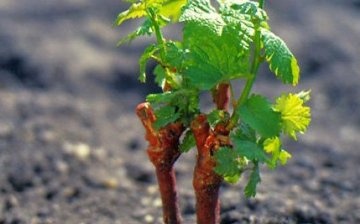


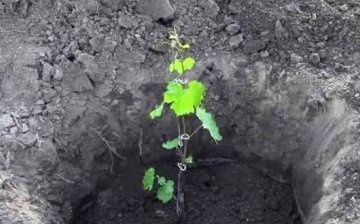
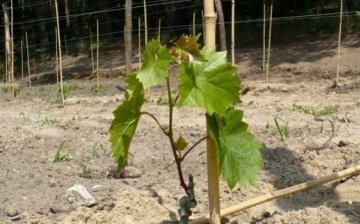






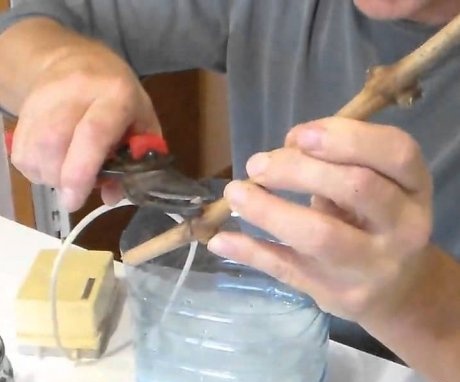
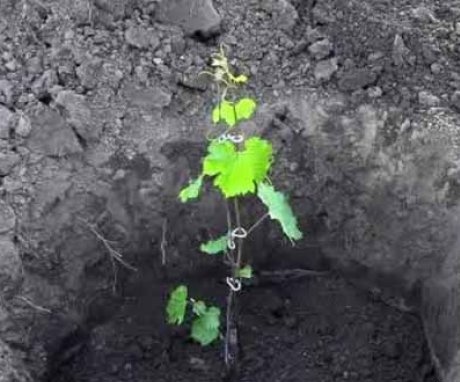
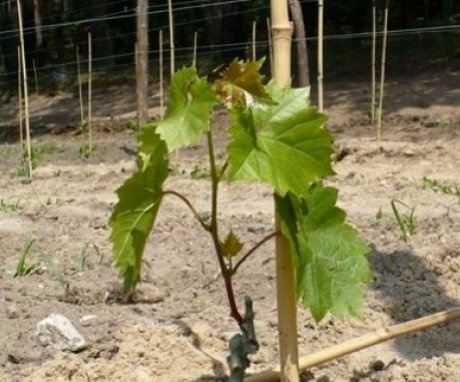
They gave me several cuttings of Isabella in the Far Eastern winter, put them in a three-liter jar of water for germination in February and warned me not to put it upside down, otherwise they would not give roots. Everything worked out and in May I planted it in open ground, as written in the article.
Pf ... that's never been able to grow by the rules. But when the mother simply puts the "extra" pieces cut in the spring into the water, they give roots, manage to root normally in the ground, and overwinter. Paradox.